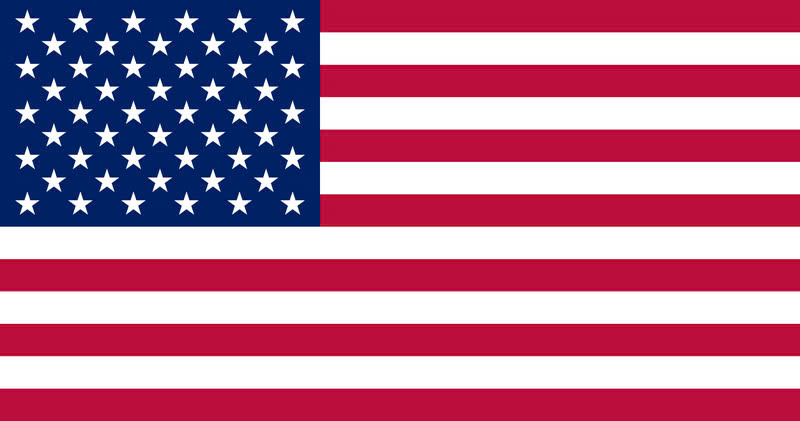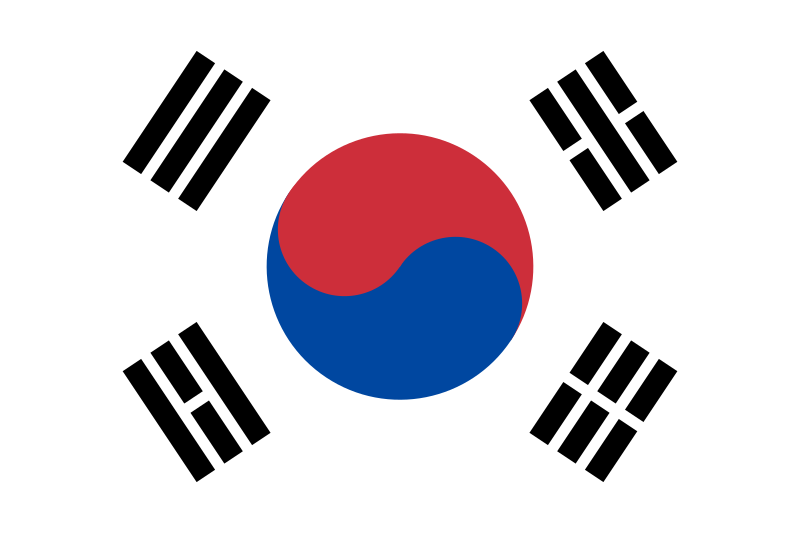Thien Cung Cave: Exploring Heaven's Palace in Ha Long Bay
When visiting Vietnam's majestic Ha Long Bay, a UNESCO World Heritage site renowned for its emerald waters and thousands of towering limestone islands, one natural wonder stands out as a must-see destination for travelers seeking both geological marvels and cultural intrigue: Thien Cung Cave, aptly named the "Heaven's Palace."
This magnificent cave, with its breathtaking stalactite and stalagmite formations, mystical atmosphere, and fascinating folklore, offers visitors a glimpse into both the natural and cultural wonders of Vietnam. If you're planning a trip to Ha Long Bay, Thien Cung Cave should undoubtedly be at the top of your itinerary.
Where is Thien Cung Cave Located?
Thien Cung Cave is situated on Dau Go Island in the southwestern part of Ha Long Bay, Quang Ninh Province, Vietnam. Located approximately 4 kilometers from Tuan Chau Port, the cave sits at an elevation of about 25 meters above sea level. Some sources also mention its position on the northern part of Dau Go Island, near Dau Go Cave, highlighting its convenient location for visitors exploring multiple attractions in the area.
Want to explore more? Check out some Dau Go Cave reviews to see why this nearby site also captivates tourists with its historical depth and impressive size.
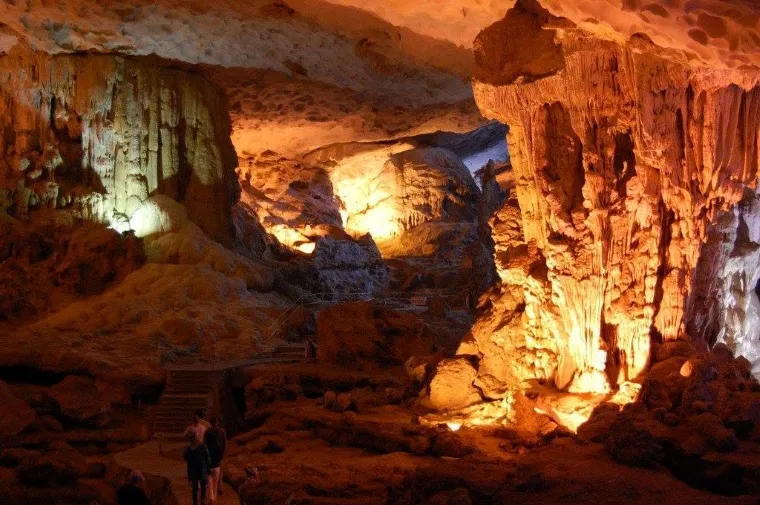
Thien Cung Cave is located on Dau Go Island in southwestern Ha Long Bay, just 4 kilometers from Tuan Chau Port - Photo Source: Vịnh Hạ Long Quảng Ninh - Thiên Đường Cảnh Vịnh
The cave is accessible via Tour Route No. 1, which is one of the most popular tourist routes in Ha Long Bay. From Halong City center, travelers can follow Highway 18 southwest to Tuan Chau Port, then take a boat to the cave. The proximity to Tuan Chau Port makes Thien Cung Cave easily accessible for day-trippers and those on overnight cruises alike.
The Discovery and History of Thien Cung Cave
What makes Thien Cung Cave's story particularly interesting is its relatively recent discovery. Unlike some ancient caves that have been known for centuries, Thien Cung was only discovered in 1993 by local fishermen seeking shelter from a storm. This accidental discovery revealed a natural wonder that had remained hidden from the world for millennia.
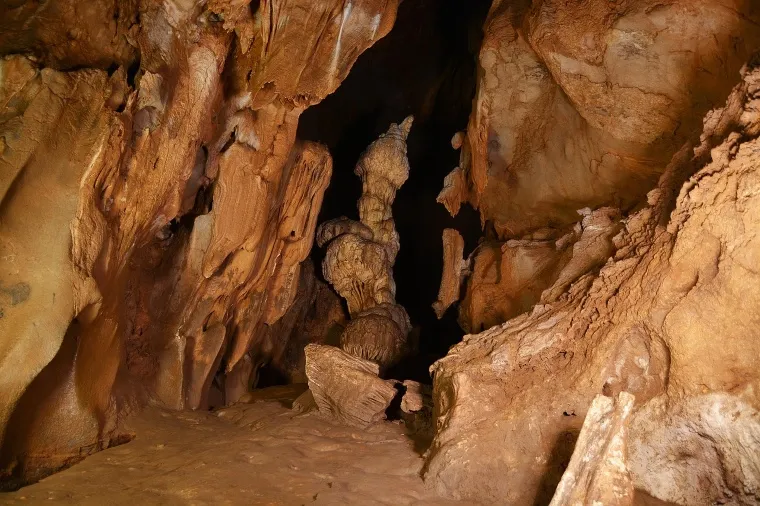
Discovered by accident in 1993, Thien Cung Cave was opened to tourists in 1998 and may have connections to ancient human activity - Photo Source: Pixabay
By 1998, the cave was officially opened to tourists, significantly boosting visitor numbers to Ha Long Bay. Thien Cung has the distinction of being the first cave in Ha Long Bay to receive major restoration and development for tourism purposes, setting a precedent for how natural attractions can be preserved while being made accessible to visitors.
Beyond its recent tourism history, Thien Cung Cave may have deeper historical significance. Some sources suggest it was a site within the Soi Nhu culture, with archaeological discoveries of shells and stone tools indicating human activity in the distant past. These findings add another layer of historical importance to this natural wonder.
The Cultural and Tourism Significance of Thien Cung Cave
Thien Cung Cave is not merely a natural formation but a cultural landmark that embodies Vietnam's connection to mythology and folklore. The cave's association with the Dragon King legend ties into Vietnam's cultural identity, where dragons are powerful symbols of prosperity and imperial power.
From a tourism perspective, Thien Cung Cave is considered an unmissable destination and one of the most beautiful caves in Ha Long Bay. Its unique structure, mystical atmosphere, and the wondrous beauty of its stalactites and stalagmites have made it a major attraction for domestic and international travelers alike.
The cave stands as a testament to Vietnam's commitment to developing natural sites for tourism while preserving their integrity. Since its opening to tourists in 1998, it has contributed significantly to tourism in Ha Long Bay, demonstrating how natural wonders can be responsibly shared with the world.
Natural Features and Structure of the Cave
Thien Cung Cave is classified as a dry cave with a complex interior structure comprising multiple levels and chambers. What makes it truly special is its abundance of spectacular stalactites and stalagmites that have formed over millions of years through slow limestone deposition.
The cave is divided into three main chambers, each with its own distinctive beauty and characteristics:
First Chamber
The first chamber greets visitors with what many describe as a magnificent painting created by nature. Here, massive formations resemble characters from fairy tales, while stalactites hang from the ceiling like crystal chandeliers. The play of light and shadow creates a magical atmosphere that immediately captivates visitors.
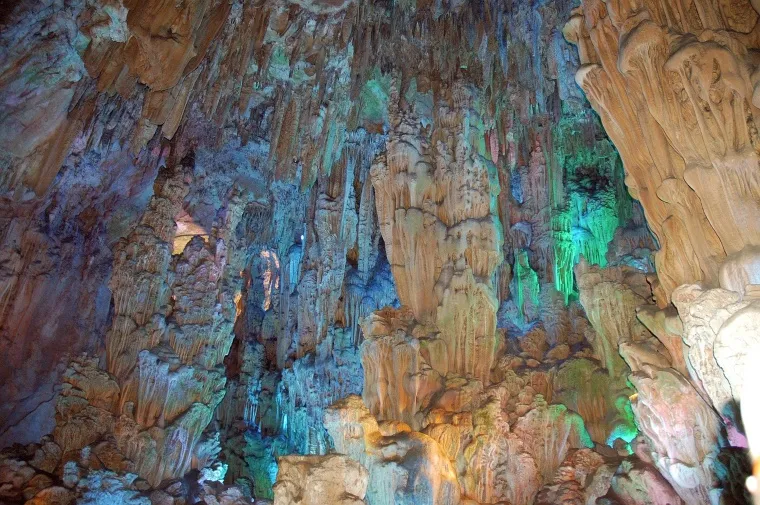
Thien Cung Cave features a multi-chamber layout filled with spectacular stalactites, stalagmites, and dramatic lighting effects - Photo Source: Pixabay
Second Chamber
Moving into the second chamber, visitors encounter large stone pillars intricately carved by nature to resemble human figures, flora, and fauna. One of the most remarkable features of this chamber is the wind passing through rock crevices, creating sounds resembling drum beats, adding an auditory dimension to the visual spectacle.
Third Chamber
The final chamber offers perhaps the most ethereal experience of all. Here, diffused light reflects off magnificent stalagmites, creating a dreamlike atmosphere. The chamber features clear blue pools fed by underground streams, which according to legend, were once bathing places for fairies.
A highlight of the cave is the "Heaven's Gate," a natural opening where sunlight streams in, creating rainbow-like glimmering effects on the limestone surfaces. The strategic installation of colored lighting systems throughout the cave enhances its mysterious beauty, illuminating the formations and creating a theatrical experience for visitors.
What to See in Thien Cung Cave
When exploring Thien Cung Cave, be sure to look out for these remarkable natural formations and features:
The Wedding Scene
In the center of the cave, a series of stone formations appears to depict the legendary wedding of the Dragon King. Visitors with imagination can discern figures that resemble the king, his bride, and their guests. This natural "sculpture garden" is made all the more impressive by the knowledge that it was created entirely by geological processes over countless millennia.
The Stone Garden
Throughout the cave, especially in the second chamber, various stalactites and stalagmites form what appears to be a garden of stone trees and flowers. These formations display an incredible variety of shapes and sizes, some resembling familiar objects or creatures, inspiring wonder at nature's artistic capabilities.
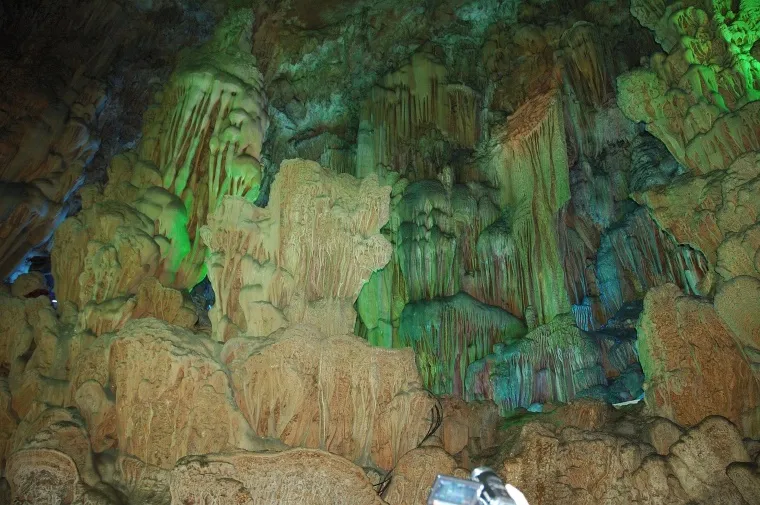
Highlights include legendary formations like the Dragon King’s wedding, stone gardens, underground lakes, and the radiant Heaven’s Gate - Photo Source: Pixabay
The Four Pillars
Four large stone columns stand proudly in one section of the cave, representing the four seasons according to local guides. These impressive formations reach from floor to ceiling and showcase different textures and colors.
Underground Lakes
Several clear pools of water throughout the cave reflect the illuminated formations above, creating a doubling effect that enhances the cave's magical quality. These pools are fed by underground streams and remain remarkably clear throughout the year.
Heaven's Gate (Cong Troi)
This natural skylight allows sunlight to penetrate the cave, creating spectacular light effects at certain times of day. When sunlight streams through Heaven's Gate, it creates a rainbow-like effect on the stone surfaces, a phenomenon that photographers and nature enthusiasts find particularly captivating.
Colored Lighting Effects
While not natural features, the strategically placed colored lights throughout the cave deserve mention. These lights highlight the natural beauty of the formations and create a dramatic atmosphere that enhances the visitor experience. The lighting brings out details in the rock formations that might otherwise be missed in the cave's natural darkness.
The Best Time to Visit Thien Cung Cave
For the optimal experience at Thien Cung Cave, timing your visit can make a significant difference:
Seasonal Considerations
The most pleasant times to visit Thien Cung Cave are from March to May and from August to October. During these months, the weather in Ha Long Bay is generally comfortable with lower humidity and fewer tourists compared to peak season. The spring months (March-May) offer cool, clear conditions that make exploration comfortable, while the early autumn months (August-October) provide stable weather after the summer rains have passed.
Summer months (June-July) can be quite hot and humid with occasional heavy rainfall, making outdoor activities less comfortable. Winter months (November-February) can be chilly and misty, which creates a mystical atmosphere but may limit visibility for photography.

Visit from March to May or August to October, and aim for early morning or late afternoon to avoid crowds and enjoy better lighting - Photo Source: Wikipedia
Time of Day
The cave is typically less crowded in the early morning or late afternoon. If you're on a day cruise, you may have less flexibility in choosing the specific time to visit. However, if possible, aiming for earlier or later in the day can provide a more peaceful experience with fewer tourists.
One advantage of visiting in the late afternoon is that the lighting conditions inside the cave often appear more dramatic as the day progresses, with the artificial lighting creating more contrast against the dimming natural light.
Practical Information for Visitors
Entrance Fees and Tours
The most common way to visit Thien Cung Cave is through Tour Route No. 1, which includes several attractions in Ha Long Bay. As of recent information, the ticket for Tour Route 1 costs approximately 290,000 VND per person (prices subject to change). This route typically includes Thien Cung Cave, Dau Go Cave, Cho Da Islet, Ba Hang Cave, Dinh Huong Islet, and Trong Mai Islet.
The total package including the boat fare may cost around 440,000 VND per person, though prices can vary depending on the type of boat and additional services. Options range from standard boats to luxury cruises and private boats, catering to different budgets and preferences.
Opening Hours
While specific opening hours may vary, Thien Cung Cave is generally open to visitors throughout the day when tour boats are operating in Ha Long Bay. Since most visitors arrive as part of organized tours, access is largely determined by tour schedules rather than strict opening hours.
What to Wear and Bring
For a comfortable exploration of Thien Cung Cave, consider these recommendations:
-
Wear comfortable, non-slip shoes as the cave floor can be wet and slippery in places
-
Dress in lightweight, breathable clothing, but bring a light jacket or long-sleeved shirt as the cave can be cooler than the outside temperature
-
Carry a small bottle of water to stay hydrated
-
Bring a camera with good low-light capabilities to capture the cave's beauty
-
Consider bringing a small flashlight for additional illumination of interesting formations
-
Pack insect repellent, especially during warmer months
Photography Tips
For the best photographs inside Thien Cung Cave:
-
Prioritize the central areas of the cave where lighting is typically better
-
Use a tripod if possible, especially for longer exposure shots
-
Experiment with different angles to capture the play of light on formations
-
Include people in some shots to provide scale and perspective
-
Focus on unique formations that appear to resemble recognizable shapes
-
Take advantage of the colored lighting for dramatic effect
-
Be patient and wait for moments when tour groups move on to capture less crowded scenes
Nearby Attractions to Visit
Ha Long Bay offers numerous attractions near Thien Cung Cave that can be combined into a comprehensive itinerary:
Dau Go Cave
Located on the same island as Thien Cung Cave, Dau Go Cave (Wooden Stakes Cave) features spacious chambers and diverse vegetation. Its name comes from a historical event when General Tran Hung Dao used wooden stakes here to prepare for a battle against Mongol invaders in the 13th century.
Thien Canh Son Cave
Another breathtaking cave in Bai Tu Long Bay. While smaller, Thien Canh Son Cave offers an enchanting experience, with a quieter setting and visible remnants of prehistoric marine life—perfect for history lovers. Delving into the Thien Canh Son Cave history reveals how geology and ancient culture blend in this lesser-known gem.
Luon Cave
A unique water cave only accessible by kayak or boat. Surrounded by limestone walls and clear waters, Luon Cave offers a tranquil, immersive nature experience perfect for photography and peaceful exploration.
Ba Hang Cave and Fishing Village
This complex includes interconnected caves and a floating fishing village where visitors can kayak and observe traditional local life on the water.
Cho Da Islet (Stone Dog Islet)
A small island formation that resembles a dog, symbolizing hope for safe sea journeys according to local beliefs.
Dinh Huong Islet (Incense Burner Islet)
An island shaped like a giant incense burner, this formation is famous enough to be featured on the 200,000 VND banknote.
Trong Mai Islet (Fighting Cocks Islet)
Two rock formations resembling roosters facing each other, this is one of the most iconic symbols of Ha Long Bay.
Sung Sot Cave (Surprise Cave)
Another famous and larger cave in Ha Long Bay, often suggested as an alternative or complementary visit to Thien Cung Cave.
![]()
Other nearby attractions include Dau Go Cave, Ba Hang fishing village, iconic islets, and additional caves and islands across Ha Long Bay - Photo Source: Facebook Vịnh Hạ Long Quảng Ninh - Thiên Đường Cảnh Vịnh
Ti Top Island
A nearby island with beautiful beaches and panoramic views accessible via a climb up 427 steps.
Luon Cave
A water cave that can be explored by boat or kayak, offering a different cave experience.
Me Cung Cave
Considered a "natural museum" with remarkable geological features.
Most Ha Long Bay cruises that include Thien Cung Cave on Tour Route No. 1 typically stop at several of these attractions as well. Visitors can also participate in activities like kayaking, swimming, rock climbing, and photography in the surrounding area, making for a full day of diverse experiences.
Tips for an Unforgettable Visit
To make the most of your visit to Thien Cung Cave, consider these insider tips:
Choose the Right Tour
Select Tour Route No. 1 when booking your Ha Long Bay experience if Thien Cung Cave is a priority. Verify that the cave is included in your itinerary, as some shorter tours may focus on other attractions.
Time Your Visit Strategically
If possible, try to arrive at the cave either early or late in the day to avoid the largest crowds. This might mean choosing a cruise with a flexible schedule or opting for a private boat tour.
Take Your Time
While guided tours move at a set pace, try to linger a bit when possible to fully appreciate the cave's beauty. Don't rush through the chambers – each offers unique formations worthy of contemplation.
Look for Shapes in the Formations
Part of the fun of visiting Thien Cung Cave is identifying shapes in the stalactites and stalagmites. Challenge yourself to find animals, objects, or figures in the stone formations – it's like nature's own Rorschach test!
Learn About the Legend Beforehand
Familiarizing yourself with the Dragon King legend before your visit will enhance your appreciation of the formations that supposedly represent characters from the story.
Consider a Professional Guide
While many tours include guides, consider hiring a knowledgeable private guide who can provide more detailed information about the geological and cultural significance of the cave.
Respect the Environment
Remember that stalactites and stalagmites take thousands of years to form. Never touch or damage these delicate formations, and always follow designated paths and guidelines to help preserve the cave for future generations.
Conclusion: A Natural Wonder Not to Be Missed
Thien Cung Cave is a stunning showcase of nature’s artistry, shaped over millions of years into a breathtaking underground wonder. With dramatic stalactites, colorful lighting, and deep ties to Vietnamese legends, it’s one of Ha Long Bay’s most magical sights.
Whether you’re drawn by geology, mythology, or simply the beauty of nature, this cave offers something for everyone. From the climb to its entrance to the panoramic views beyond, the journey is as rewarding as the destination.
Add Thien Cung Cave to your Ha Long Bay itinerary for an unforgettable experience that blends natural wonder with cultural charm—a true highlight of any Vietnam adventure.
|
Joytime Travel Agency - Travel JOY, TIMEless Vietnam Follow us for travel tips, local insights, and exclusive offers:
|

Danish Nguyen
Danish Nguyen is a renowned travel blogger in Vietnam with over 5 years of experience sharing unique travel experiences. With a passion for exploring new places, Danish captures incredible moments and provides readers with valuable tips to discover the beauty of his homeland.



